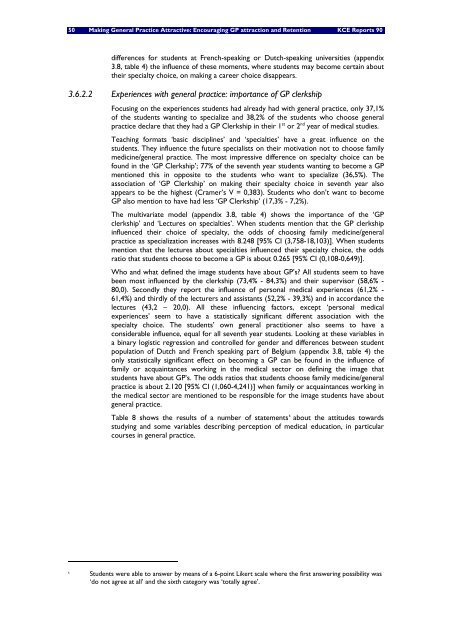Huisartsgeneeskunde: aantrekkingskracht en beroepstrouw ... - Lirias
Huisartsgeneeskunde: aantrekkingskracht en beroepstrouw ... - Lirias
Huisartsgeneeskunde: aantrekkingskracht en beroepstrouw ... - Lirias
Create successful ePaper yourself
Turn your PDF publications into a flip-book with our unique Google optimized e-Paper software.
50 Making G<strong>en</strong>eral Practice Attractive: Encouraging GP attraction and Ret<strong>en</strong>tion KCE Reports 90<br />
differ<strong>en</strong>ces for stud<strong>en</strong>ts at Fr<strong>en</strong>ch-speaking or Dutch-speaking universities (app<strong>en</strong>dix<br />
3.8, table 4) the influ<strong>en</strong>ce of these mom<strong>en</strong>ts, where stud<strong>en</strong>ts may become certain about<br />
their specialty choice, on making a career choice disappears.<br />
3.6.2.2 Experi<strong>en</strong>ces with g<strong>en</strong>eral practice: importance of GP clerkship<br />
Focusing on the experi<strong>en</strong>ces stud<strong>en</strong>ts had already had with g<strong>en</strong>eral practice, only 37,1%<br />
of the stud<strong>en</strong>ts wanting to specialize and 38,2% of the stud<strong>en</strong>ts who choose g<strong>en</strong>eral<br />
practice declare that they had a GP Clerkship in their 1 st or 2 nd year of medical studies.<br />
Teaching formats ‘basic disciplines’ and ‘specialties’ have a great influ<strong>en</strong>ce on the<br />
stud<strong>en</strong>ts. They influ<strong>en</strong>ce the future specialists on their motivation not to choose family<br />
medicine/g<strong>en</strong>eral practice. The most impressive differ<strong>en</strong>ce on specialty choice can be<br />
found in the ‘GP Clerkship’; 77% of the sev<strong>en</strong>th year stud<strong>en</strong>ts wanting to become a GP<br />
m<strong>en</strong>tioned this in opposite to the stud<strong>en</strong>ts who want to specialize (36,5%). The<br />
association of ‘GP Clerkship’ on making their specialty choice in sev<strong>en</strong>th year also<br />
appears to be the highest (Cramer’s V = 0,383). Stud<strong>en</strong>ts who don’t want to become<br />
GP also m<strong>en</strong>tion to have had less ‘GP Clerkship’ (17,3% - 7,2%).<br />
The multivariate model (app<strong>en</strong>dix 3.8, table 4) shows the importance of the ‘GP<br />
clerkship’ and ‘Lectures on specialties’. Wh<strong>en</strong> stud<strong>en</strong>ts m<strong>en</strong>tion that the GP clerkship<br />
influ<strong>en</strong>ced their choice of specialty, the odds of choosing family medicine/g<strong>en</strong>eral<br />
practice as specialization increases with 8.248 [95% CI (3,758-18,103)]. Wh<strong>en</strong> stud<strong>en</strong>ts<br />
m<strong>en</strong>tion that the lectures about specialties influ<strong>en</strong>ced their specialty choice, the odds<br />
ratio that stud<strong>en</strong>ts choose to become a GP is about 0.265 [95% CI (0,108-0,649)].<br />
Who and what defined the image stud<strong>en</strong>ts have about GP’s? All stud<strong>en</strong>ts seem to have<br />
be<strong>en</strong> most influ<strong>en</strong>ced by the clerkship (73,4% - 84,3%) and their supervisor (58,6% -<br />
80,0). Secondly they report the influ<strong>en</strong>ce of personal medical experi<strong>en</strong>ces (61,2% -<br />
61,4%) and thirdly of the lecturers and assistants (52,2% - 39,3%) and in accordance the<br />
lectures (43,2 – 20,0). All these influ<strong>en</strong>cing factors, except ‘personal medical<br />
experi<strong>en</strong>ces’ seem to have a statistically significant differ<strong>en</strong>t association with the<br />
specialty choice. The stud<strong>en</strong>ts’ own g<strong>en</strong>eral practitioner also seems to have a<br />
considerable influ<strong>en</strong>ce, equal for all sev<strong>en</strong>th year stud<strong>en</strong>ts. Looking at these variables in<br />
a binary logistic regression and controlled for g<strong>en</strong>der and differ<strong>en</strong>ces betwe<strong>en</strong> stud<strong>en</strong>t<br />
population of Dutch and Fr<strong>en</strong>ch speaking part of Belgium (app<strong>en</strong>dix 3.8, table 4) the<br />
only statistically significant effect on becoming a GP can be found in the influ<strong>en</strong>ce of<br />
family or acquaintances working in the medical sector on defining the image that<br />
stud<strong>en</strong>ts have about GP’s. The odds ratios that stud<strong>en</strong>ts choose family medicine/g<strong>en</strong>eral<br />
practice is about 2.120 [95% CI (1,060-4,241)] wh<strong>en</strong> family or acquaintances working in<br />
the medical sector are m<strong>en</strong>tioned to be responsible for the image stud<strong>en</strong>ts have about<br />
g<strong>en</strong>eral practice.<br />
Table 8 shows the results of a number of statem<strong>en</strong>ts t about the attitudes towards<br />
studying and some variables describing perception of medical education, in particular<br />
courses in g<strong>en</strong>eral practice.<br />
t Stud<strong>en</strong>ts were able to answer by means of a 6-point Likert scale where the first answering possibility was<br />
‘do not agree at all’ and the sixth category was ‘totally agree’.

















